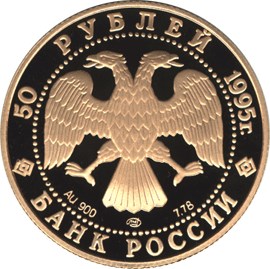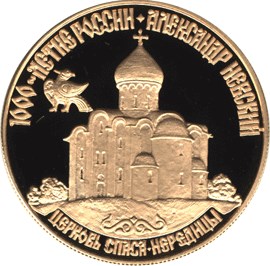Alexander the Nevsky
Obverse
in the center — the Emblem of the Bank of Russia (the two-headed eagle designed by I.Bilibin), the letters under it indicate the metal sign, the fineness, the mint trademark and the fine metal content. The inscriptions along the rim framed by a circle of dots: at the top — «50 РУБЛЕЙ 1995 г.» (50 RUBLES 1995), at the bottom — «БАНК РОССИИ» (BANK OF RUSSIA) ,
Reverse
a view of the Church of the Saviour on the Nereditsa near Novgorod, to the left - the mythical bird Sirin, the inscriptions along the rim: at the top - «1000-ЛЕТИЕ РОССИИ * АЛЕКСАНДР НЕВСКИЙ" (THE MILLENIUM OF RUSSIA * ALEXANDER THE NEVSKY), at the bottom - "ЦЕРКОВЬ СПАСО-НЕРЕДИЦЫ" (THE SAVIOUR'S CHURCH ON THE NEREDITZA RIVER).
Authors
The artist: A.V. Baklanov
The sculptors: A.V. Baklanov, A.A. Dolgopolova
Moscow Mint (ММД)
The edge: 200 corrugations
Alexander the Nevsky (1220-1263), a Novgorod prince, was an outstanding Russian military commander, statesman, political leader and diplomat. He was born in Pereslavl-Zelessky and all his wide-ranging activities are linked with one of the most difficult periods of Russian history. The north-eastern and southern part of Russia languished under the Tatar-Mongol yoke, while the north-west of Russia was attacked by the German and Swedish knights. Alexander the Nevsky led the struggle against the foreign invaders and his troops defeated the Swedish army on the River Neva in 1240 and the German knights on Lake Chudskoye in 1242. In 1252 he became the Grand Duke of Vladimir. Alexander the Nevsky died on November 15, 1263, in Gorodets, a town on the Volga. He was canonised by the Russian Orthodox Church.


